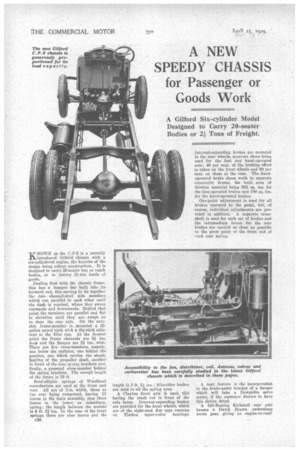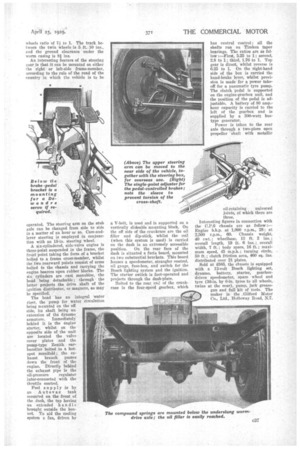ANEW SPEEDY CHASSIS for Passenger or Goods Work
Page 60

Page 61

If you've noticed an error in this article please click here to report it so we can fix it.
KNOWN as the C.P.6 is a recently introduced Gilford chassis with a six-cylindered engine, the keynote of the design being robust construction. It is designed to carry 20-seater bus or coach bodies, or to convey 2i-ton loads of goods.
Dealing first with the chassis frame, this has a bumper bar built into its forward end, this serving to tie together the two channel-steel side members which run parallel to each other until the dash is reached, where they sweep outwards and downwards. Behind that point the members are parallel and fiat in elevation until they are swept up to clear the rear axle. On the nearside frame-member is mounted a 22gallon petrol tank with a dip-stick adjacent to the filler cap. At the deepest point the frame channels are 81 ins. dee', and the flanges are 21 ins. wide. There are five cross-members, namely, one below the radiator, one behind the gearbox, one which carries the steady bearing of the propeller shaft, another in front of the rear string brackets and, finally, a gnsseted cross-member behind the spring brackets. The overall length of the frame is 19 ft.
Semi-elliptic springs of Woodhead manufacture are used at the front and rear. All are of 3-in, width, those at the rear being compound, having 11 leaves in the main assembly, plus three leaves" in the lower, or subsidiary, spring • the length between the centres is 4 ft. 21 ins. In the ease of the front springs there are nine leaves and the c36
length is 3 ft. 51 ins.; Silentbloc bushes are used in all the spring eyes.
A Clayton front axle is used, this having the track rod in front of the axle beam. .Internal-expanding brakes are provided for the front wheels, which are of the eight-stud disc type running -on Timken taper-roller bearings. Internal-expanding brakes are mounted in the rear wheels, separate shoes being used for the foot and hand-operated sets; 40 per cent. of the braking effort is taken on the front wheels and 60 per cent. on those at the rear. The handoperated brake shoes work in separate concentric drums, the total area of friction material being 282 sq. ins, for the foot-operated brakes and 180 sq. ins, for the band-operated brakes.
One-point adjustment is used for all brakes operated by the pedal, but, of course, individual adjustments are provided in addition. A separate crossshaft is used for each set of brakes and the intermediate levers for the rear brakes are carried as close as possible to the pivot point of the front end of each rear spring.
• A neat feature is the incorporation in the brake-pedal bracket of a hanger which will take a Dewandre servo motor, if the customer desires to have this device fitted.
A full-floating Kirkstall rear axle houses a David Brown underslung worm gear, giving an engine-to-road
wheels ratio of 7i to 1. The track between the twin wheels is 5 ft. 10 ins., and the ground clearance under the worm casing is 81 ins.
An interesting feature of the steering gear is that it can be mounted on either the right or left-side frame-member, according to the rule of the road of the country in which the vehicle is to be operated. The steering arm on the stub axle can be changed from side to side in a matter of an hour or so. Cam-andlever steering is employed in conjunction with an 18-in, steering wheel.
A six-cylindered, side-valve engine is three-point suspended ib the frame, the front point taking the form of a bracket bolted to a frame cross-member, whilst the two rearward points consist of arms bolted to the chassis and carrying the engine bearers upon robber blocks. The six cylinders are cast monobloc, the head being detachable; through the latter projects the drive shaft of the ignition distributor, or magneto, as may be specified. The head has an integral water riser, the pump for water circulation being mcunted on the off side, its shaft being an extension of the dynamo armature. Immediately behind it is the engine starter, whilst on the opposite side of the unit are located the valve cover plates and the pomp-type Zenith carburetter bolted to a hotspot manifold ; the exhaust branch passes clown the front of the engine. Directly behind the exhaust pipe is the
oil-pressure regulator inter-connected with the throttle control.
Pnel supply is by an Autovac tank mounted on the front of the dash, the tap having an extended handle brought outside the bonnet. To aid the cooling system a fan, driven by a V-belt, is used and is supported on a vertically slideable mounting block. On the off side of the crankcase are the oil filler and dip-stick, whilst the coil (when this system is used) is carried on the dash in an extremely accessible position. On the rear face of the dash is situated a facia board, mounted on two substantial brackets. This board houses a speedometer, strangler control, oil gauge, fuse-box, and switch for the Bosch lighting system and the ignition. The starter switch is foot-operated and projects through the dash-plate.
Bolted to the rear end of the crankcase is the four-speed gearbox, which
has central control; all the shafts run on Timken taper bearings. The ratios are is follow :—First, 5.25 to 1; second, 2.8 to 1; third, 1.76 to 1. Top gear is direct, whilst reverse is 6.25 to 1. On the right-hand side of the box is carried the hand-brake lever, whilst provision is made for a power takeoff for a pneumatic tyre pump. The clutch pedal is supported on the engine-gearbox unit, and the position of the pedal is adjustable. A battery of 80 amp.hour capacity is carried to the left of the gearbox and is supplied by a 300-watt bustype generator.
Power is taken to the rear axle through a two-pieee open propeller 'shaft with metallic oil-retaining universal joints, of which there are three.
Interesting figures in connection with the C.P.6 chassis are as follow:— Engine b.h.p. at 1,000 r.p.m., 28; at 2,500 r.p.m., 60. Chassis weight, 40 cwt.; wheelbase, 13 ft. 3 ins.; overall length, 19 ft. 6 ins. ;. overall width, 7 ft.; body space, 16 ft.; maximum speed. 45 m.p.h.; turning circle, 50 ft.; clutch friction area, 460 sq. ins. distributed over 21 plates.
Sold at 1585, the chassis is equipped with a 12-volt Bosch lighting set, dynamo, battery, starter, gearboxdriven speedometer, spare wheel and tyre (36-in. by 6-in. tyres to all wheels, twins at the rear), pump, jack greasegun and full kit of tools. The maker is the _Gifford Motor Co., Ltd., Holloway Road, N.7.














































































































